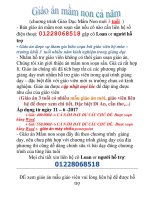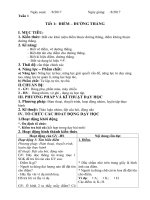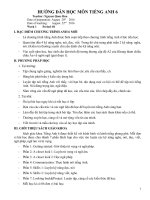Giao an ca nam moi 1920
Bạn đang xem bản rút gọn của tài liệu. Xem và tải ngay bản đầy đủ của tài liệu tại đây (196.88 KB, 43 trang )
WEEK: 1
PERIOD: 1
DATE: 11/ 8/2019
GIỚI THIỆU CHƯƠNG TRÌNH
(Hướng dẫn phương pháp học bộ môn)
I. OBJECTIVES:
1. Knowledge: By the end of this lesson Ss will be able to guide students
how to learn English 11
2. Skills and competence
General competence
Specific competence
- Self- study
- Problem solving
It depends on each lesson.
- Creatively
- Communication
- Co-operation
- Using language
3. Students’ attitude: Students know about English book in grade 11 and
know how to learn English 11.
II. TEACHING AIDS: Textbook, chalk, board
III. TEACHING METHODS: Integrated, mainly communicative
IV. PROCEDURE:
1-Settlement: Greeting the class & checking students’ attendance.
2-Checking: Asking Ss to answer some questions:
3- New lesson:
Teacher’s activities
A. WARM -UP: (3’)
Students’ activities
Develop sts’ competences in cooperation, using
language
Lucky Number
-T divides the whole class into two groups and
play game
1.Lucky Number
2.How many boys are there in your class?
3.Do you know what your English teacher’s name
is?
Work in group of two.
The leader of each group
chooses a number for your
own group and do the
following requirement in
each question.If the answer
is correct they will get 10
marks.
4.Lucky Number
5.What do you prepare for this semester?
6.Do you like studying English?Why or Why
not ?
7.How do you learn English well?
8.Do you speak English fluently?
B. PRESENTATION: (20’)
Develop sts’ competences in cooperation, using
language
-Content: Including six topics
Students listen to T’s
explanation about six
topics
1.You and me
2.Education
3.Community
4.Recreation
5.Nature and Environment
6.People and places
-> six topics are divided into sixteen units
We are studying 14 units
Listen and take notes in
their notebooks.
-The design of each unit in textbook:
1.Unit: express the theme
2.Reading: developing reading skill
3.Speaking: developing speaking skill
4.Listening: developing listening skill
5.Writing: developing writing skill
6.Language focus: learning grammar and
pronunciation
- After 3 unit, you have one period for test
yourself. It helps you test yourself about what
you’ve learnt.
Listen and take notes in
their notebooks.
1-check frequence knowledge for the previous
lesson.
2-Fifteen minutes test (3 times)
3-One period test (2 times )
4-Semester test (Once for each semester)
- The new point in learning E 10
-Communicative method /approach
-Task - based method /teaching
-The book is designed with 4 skills
-Complete and various to Ss
- Learner - centered approach
C. PRACTICE (20’)
Develop sts’ competences in cooperation, using
language
-T asks Ss to work in pairs and make acquainted
with a friend by using suggested questions:
Work in pair and make a
small conversation with a
friend.
1.What’s your name?
2.How old are you?
3.Where do you live?
4.Where do you study?
5.What subjects do you study at school?
6. What’s your favorite subject? Why do you like
it?
7.What do you often do in your free-time?
8.What do you want to be in the future?
D. HOMEWORK:
Listen and take notes in
their notebooks
(2’)
Develop sts’ competences in cooperation, using
language
- Prepare revision
WEEK: 1
PERIOD: 2
DATE: 11/ 8/ 2019
ÔN TẬP
I. OBJECTIVES:
1. Knowledge: By the end of this lesson Ss will be able to help Ss review
knowledge to prepare for the input test
2. Skills and competence
General competence
Specific competence
- Self- study
- Problem solving
Integrated skills
- Creatively
- Communication
- Co-operation
- Using language
3. Students’ attitude: - Ss will be able to recall the knowledge they have
learnt to do exercise.
II. TEACHING AIDS: Textbook, chalk, board
III. TEACHING METHODS: Integrated, mainly communicative
IV. PROCEDURE:
1-Settlement: Greeting the class & checking students’ attendance.
2-Checking: Asking Ss to answer some questions:
3- New lesson:
Teacher’s activities
Students’ activities
A. WARM UP (2 minutes)
Develop sts’ competences in cooperation,
using language & creativity
- Greeting
Do as directed
- Checking homework
B. PRESENTATION (2 minutes)
Develop sts’ competences in cooperation,
using language ,& Problem solving
- Introduce the content of the lesson briefly
- Ask Ss to do these exercises
- Ask Ss to do input test
C. PRACTICE (40 minutes)
Develop sts’ competences in cooperation,
using language ,Communication
Listen to the T
& Problem solving
- T delivers handouts and ask them to work
individually.
Do exercises individually
- After some mns T calls on some Ss to check
Present in frond on the class
out.
Listen and take note
- Feedback.
D. HOMEWORK: (1mn)
Develop sts’ competences in Creativity, Selfstudy
- Do the task again
- Prepare for the next lesson.
Listen and write down
Handout
Choose the best answers
Câu 1: It (A) was not until 1915(B) that the cinema really (C) become (D)
an industry
Câu 2: (A) My bike, (B) whom I (C) had left at the gate,(D) disappeared.
Câu 3: Youshould (A)bringanumbrella (B)inorder (C)protectyourselffrom
(D)rain.
Choosethebestanswertocompleteeachsentence.
Câu 4: I spent the evening …………... with my friends.
A. to chat
B. chatting C. chat
D. for chatting
Câu 5: The building was completely _____________ by fire.
A. destruction
destructive
B. destructively
C. destroyed
D.
Câu 6: Mary is ________ worker, she works for the big company.
A. an
B. a
C. the
D. Ø
Câu 17: London is ………... the river Thames.
A. in B. at C. of D. on
Câu 7: Those boys_________play football on the street. It's very dangerous.
A. should
needn’t
B. shouldn’t
C. can’t
D.
Câu 8: How many countries took part in the first World Cup?
A. interested
operated
B. participated
C. competed
D. co.
Câu 9: The boy is wearing a(n) ............ shirt. It’s too long and lose.
A. oversizedB. small-sized
C. large-sized D. medium-sized
Câu 10: I didn’t know Tom was in hospital. If I
___________,I_____________to visit him.
A. had known / would have gone
B. knew / would go
C. know / will go
D. knew / would have gone
Câu 11: A: ________ are you learning Chinese for? –B: To sing Chinese
songs.
A. When
B. Where
C. What
D. Why
Câu 12: .................. is our national anthem composed?
A. By whomB. Whom
C. By who
D. With whom
Câu 13: The lift is out of order, ................ is too bad.
A. that
B. which
C. who
D. where
Câu 14: What should we do to reduce the level of ………….....?
A. pollutes B. pollution C. pollute
D. polluting
Câu 15: Music can ________ ideas, thoughts and feeling.
A. express
compose
B. play
C. talk
D.
Câu 16: Germany was the ________ of the 2006 World Cup. The 18th World
Cup was held there.
A. trophy
B. host nation
C. continent
D. tournament
Câu 17: World Cup is considered the most popular event in the world.
A. the continent
B. the region
C. the globe D. the
nation
Câu 18: I went to the library ________ last night.
A. for studying
B. studying
C. to study
D. to studying
Câu 19: She felt _________at the end of the film. It is an ___________love
story film.
A. surprised – interested
B. surprised – interesting
C. surprising – interesting
interested
D. surprising –
Câu 20: There are various ……………... and animals in tropical forests.
A. planter
B. plant
C. plantations
D. plants
Put the verbs in brackets in the present simple or the present continuous
tense.
1/ I (have) __________ coffee for breakfast every day.
2/ My brother (work) __________ in a shoe store this summer.
3/ The student (look) ___________ up that new word now.
4/ She (go) __________ to school every day.
5/ We (do) __________ this exercise at the moment.
6/ Miss Helen (read) ___________ a newspaper now.
7/ It (rain) __________ very much in the summer. It (rain) _________ now.
8/ Bad students never (work) __________ hard.
9/ He generally (sing) __________ in English, but today he (sing)
_________ in Spanish.
10/ We seldom (eat) __________ before 6.30
WEEK: 1
PERIOD: 3
DATE: 11/8/2019
ÔN TẬP VÀ KHẢO SÁT CHẤT LƯỢNG ĐẦU NĂM
I. OBJECTIVES:
1. Knowledge: By the end of this lesson Ss will be able to help Ss review
knowledge to prepare for the input test
2. Skills and competence
General competence
Specific competence
- Self- study
- Problem solving
Integrated skills
- Creatively
- Communication
- Co-operation
- Using language
3. Students’ attitude: - Ss recall the knowledge they have learnt to do this
test.
II. TEACHING AIDS: Textbook, chalk, board
III. TEACHING METHODS: Integrated, mainly communicative
IV. PROCEDURE:
1-Settlement: Greeting the class & checking students’ attendance.
2-Checking: Asking Ss to answer some questions:
3- New lesson:
Teacher’s activities
A. WARM UP (2 minutes)
Students’ activities
Develop sts’ competences in cooperation,
using language & creativity
- Greeting
Do as directed
- Checking homework
B. PRESENTATION (2 minutes)
Develop sts’ competences in cooperation,
using language ,& Problem solving
- Introduce the content of the lesson briefly
Listen to the T
- Ask Ss to do these exercises
- Ask Ss to do input test
C. PRACTICE (40 minutes)
Develop sts’ competences in cooperation,
using language ,Communication
& Problem solving
- T delivers handouts and ask them to work
individually.
Do input test individually
D. HOMEWORK: (1mn)
Develop sts’ competences in Creativity, Selfstudy
- Do the task again
Listen and write down
- Prepare for the next lesson.
Handout:
INPUT TEST ( 15’)
I. Choose the best answer:
Câu 1: Would you like _____to the cinema with us tomorrow evening?
A. to come
coming
B. come
D. came
C.
Câu 2: Jane_____ for the telephone company, but now she has a job at the
post office.
A. used to working
B. used to work
C. is used to working
D. is used to work
Câu 3: Most of the goods_____ in this factory are exported.
A. making
made
B. which make
C. which are made
D. are
Câu 4: Jane: “Someone is knocking at the door.” - Mary: “_____it now.”
A. I'll open
I opened
B. I am opening
C. I am going to open
D.
Câu 5: If you _____a choice, which country would you visit?
A. have
B. had
C. have had
D. will have
Câu 6: Choose the word that has the underlined part pronounced differently
from the others A. sees
B. sports
C. pools
D. trains
Câu 7: Minh passed the entrance exam of Hanoi University with flying
colours.
A. very low mark
mark
B. very soft mark
C. very high mark
D. very tall
II. Read the passage and choose the correct answer:
Germany had one of the lowest rates of unemployment back in 1980. It
stood at just 3%. Now the rate is increasing. The United States has had ups
and downs. In 1980, it was about 1% lower than that in Germany; 7.5% in
1981; and in 1984, it was the same rate as in 1980. Great Britain heads the
employment chart. In 1980, their situation was the same as the United
States, then followed a sharp rise in 1981, when the rate was 10.5%. This
rose gradually over the next two years to 13%. There was no great change
until two years later people saw another increase to about 13.5% and figures
do not look as though they are on their way down yet.
Câu 8: What was the rate of unemployment in Germany in 1980?
A. 2%
D. 1%
B. 3%
C. 7.5%
Câu 9: What was the rate of unemployment in the United States in 1984?
A. 2%
D. 1%
B. 7.5%
C. 10.5%
Câu 10: Which country had the highest rates of unemployment?
A. Germany
D. Britain
B. France
C. The US
Kí duyệt giáo án
ngày.....tháng..... năm 2019
Người
kiểm tra
TT. Vũ Thị Lan
Hường
WEEK 2
PERIOD 4
PLANNING DATE: 18/ 8/2019
TEACHING DATE:
UNIT 1: FRIENDSHIP
Lesson 1: Reading
I. Objectives:
1. Knowledge:
- General knowledge: Students know about how to make and to keep friends
long.
- Language: Sentences and expression for describing qualities of true
friendship.
- New words: Words related to qualities of friendship.
2. Skills and Competence:
General competence
Specific competence
- Self- study
- Guessing meaning of the words in
context.
- Problem solving
- Creativity
- Identifying main idea.
- Communication
- Passage comprehension.
- Co-operation
- Using language
3. Students’ attitude: Students should know what a friendship is, know
how to keep a friend long.
II. Teaching Methods: Integrated, mainly communicative.
III. Teaching aids: Student’s books, notebooks, chalks board, etc.
IV. Procedures:
check the number of students
check the diagram of class
Teacher’s activities
Students’ activities
A. Warm-up: (5 minutes)
Develop sts’ competences in
cooperation, using language &
creativity
- Ask students the questions:
- Have you got many friends?
- Who is your best friend?
- What do your friends and you do in
your free time?
- Let students understand more about
activities and qualities of friends, then
say to students: Today we learn Unit
1- part A: Reading.
B. Before you read : (7 minutes)
Develop sts’ competences in
- Listen to the teacher and answer the
questions:
- Yes, I have.
- A is my best friend.
- We usually come to the library
sometimes play foot ball.
- Listen to the teacher and open the book
– Unit 1, part A: reading.
cooperation, using language &
creativity
- Ask students to look at the picture
and read the poem in their books.
- Ask students to discuss then ask and
answer the question:
What do you think of the friend in the
poem?
- Look at the picture in the book, listen to
the teacher, read the poem then ask and
answer the question, work in pairs:
A: What do you think of the friend in the
poem?
B: I think.
-Let them work in pairs.
-Listen to students and correct
pronunciation and grammar if
necessary.
-Show students to know about friends.
- Listen to the teacher.
C. While you read : (23 minutes)
Develop sts’ competences in
cooperation, using language
,Communication
& Problem solving
- Ask students to look through the
passage and read in silence.
- Listen to the teacher then read the
passage.
- Help students read the passage.
- Ask some new words if necessary.
- Explain pronunciation and meaning
of new words which appear in the
passage.
- Keep the book open.
Task 1 : (3 minutes)
Develop sts’ competences in guessing
the meaning of words based on
contexts and components of the words
- Ask students to fill each blank with a
suitable word/phrase.
- Listen to the teacher then do task 1.
- Ask the teacher if necessary.
- Let students work individual or in
groups.
- Help students if necessary.
- Work individual or in group.
-Write down the true keys in the
notebook.
Task 2: (4 minutes)
- Ask students look through the
passage then try to choose which of
the choices A, B, C,or D most
adequately sums up the idias of the
whole passage.
- Let them work in pairs.
Task 3: (6 minutes)
- Ask students to scan the passage and
answer the questions:
- Let them work in pairs.
- Listen to the teacher.
- Look through the passage again and try
to choose the most adequately sums up
the idia of the whole passage.
- Practice with a partner then write the
key down in the note book.
- Ask the teacher if necessary.
- Walk round and help students.
- Ask some students to stand up to ask
and answer each other.
- Walk round the classroom and
correct mistakes.
- Listen to the teacher then ask and
answer the questions in the book:
1. The first quality for true friendship is
unselfishness.
D. After you read : (8 minutes)
2. Changeable and uncertain people are
incapable of.
Develop sts’ competences in
cooperation, using language,
Communication, creativity
3. The third quality for friendship is
loyalty.
- Ask students to discuss the question:
“ Why do we need to have friends? ’’
........
- Listen to the teacher.
- Let them work in pairs.
- Ask them to report the results to the
class.
- Try to discuss the question.
- Listen to students and correct
mistakes.
- The students who are called to stand up
to report the result to the class loudly.
E. Home work: (2 minutes)
Develop sts’ competences in
Creativity, Self- study
- Ask students to write a passage about
their friendships (80 words)
- Ask students to do Reading exercise
of Unit 1 in workbook and prepare
Part B : Speaking at home
- Listen to the teacher and write down
homework
WEEK 2
PERIOD 5
PLANNING DATE: 18/ 8/2019
TEACHING DATE:
UNIT 1: FRIENDSHIP
Lesson 2: Speaking
I. Objectives:
1. Knowledge:
- General knowledge: Students learn about physical characteristics and
personalities of a person.
- Language: Talking about people’s physical characteristics and
personalities.
- New words: words related to people’s physical characteristics and
personalities.
2. Skills and competence
General competence
Specific competence
- Self- study
- Talking about a famous friend.









